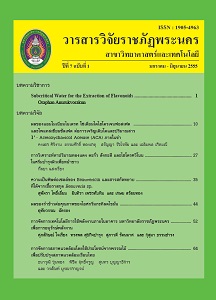Subcritical Water for the Extraction of Flavonoids
Keywords:
Subcritical water extraction, FlavonoidsAbstract
Flavonoids are secondary plant metabolites in various medicinal plants, which occurs in free state (i.e., aglycone) and glycosides. The basic structure of flavonoids consists of a phenolic ring with 2-phenylbenzopyrone (flavone). Their derivatives differ in the substitutions, the number and position of hydroxyl and methoxy groups, and the number of sugar moieties in the molecules (Suntornsuk & Anurukvorakun, 2005). Moreover, flavonoids perform important pharmacological activities, such as antiallergy, anti-inflammatory (Xie, et al., 2012), anti-viral antimicrobial activities (Chirumbolo, 2010), anticancer (Chidambara Murthy et al, 2012; Xie et al., 2012), antimicrobial activities (Al-Oqail et al., 2012) and antioxidant (Haq Ihsan, et al, 2012; Schirrmacher, et al.,2007). However, the traditional extraction method of flavonoids from plant tissues has usually been accomplished using conventional extraction processes such as solid–liquid extraction employing methanol, ethanol, acetonitrile and acetone and also through steam distillation. Such sample preparation procedure is a considerable step. Especially, the methods for the determination of trace analysis in medicinal plants are usually various procedures. These procedures are disadvantaged by the consumption of organic solvents which leads too low to meet the challenges of modern environmental analysis. Whereas, supercritical water extraction (SWE) can play a significant role to overcome the drawbacks. Other common terms of subcritical water are hot water extraction, pressurized (hot) water extraction, high-temperature water extraction, superheated water extraction or hot liquid water extraction. In recent years, numerous papers have been published on the applicability of SWE for the extraction of bioactive compounds from plant. SWE is an environmentally kindly technique for the future based on using water as extraction solvent at temperatures between 100°C and 374°C (critical point of water, 374°C and 22 MPa at high pressure which is high enough to keep the water in the liquid solvent) (Ramos et al.,2012). Increasing the temperature at moderate pressure also reduces the surface tension and viscosity of water causes the subcritical water is comparable with organic solvents. Unlike, organic solvents, there is no environmental impact associated with water. The ultimate goal of this article is to explain the fundamental principles of the SWE and its application for the extraction of flavonoids. The main factors affecting the SWE efficiency such as temperatures, pressure, extraction time and flow rate will be discussedDownloads
Issue
Section
บทความทางวิชาการ (Article)
License
โปรดกรอกเอกสารและลงนาม "หนังสือรับรองให้ตีพิมพ์บทความในวารสารวิจัยมหาวิทยาลัยราชภัฏพระนคร สาขาวิทยาศาสตร์และเทคโนโลยี" ก่อนการตีพิมพ์




